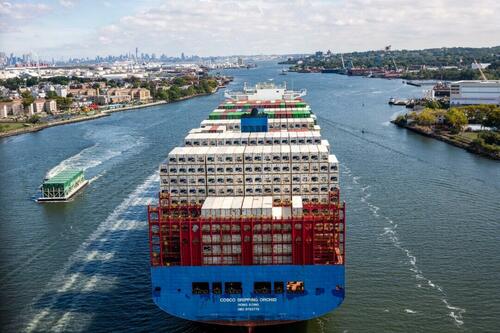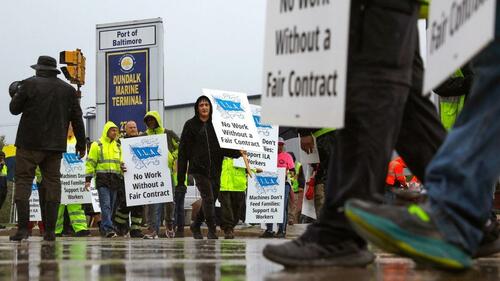
Authored by Andrew Moran via The Epoch Times,
“No automation means no automation,” says the International Longshoremen’s Association (ILA), the union representing 85,000 dock and maritime workers.
ILA officials reached a tentative wage agreement with the United States Maritime Alliance (USMX) on Oct. 3. This move effectively suspended the three-day job action and extended the existing Master Contract until Jan. 15. The new deal allows both sides about 100 days to negotiate a new agreement, with automation being the primary sticking point.
While ILA confirmed that USMX agreed to raise pay for thousands of port workers, they are now focusing their discussions on using technology to complete tasks with less human intervention. The union is seeking to ban the automation of container-moving trucks, cranes, and gates.
Union negotiators are now seeking greater protections from the possibility of jobs being replaced by automation and semi-automation, which might be a substantial stumbling block to preventing another round of work stoppages in the new year.
“Automation will continue to be an issue that will be worked out and is being worked out in this contract,” said ILA President Harold Daggett in a statement.
“The ILA negotiated restrictions on automation and semi-automation in the last contract. The ILA just wants to tighten the language that no automation means no automation.”
State of Automation at Ports
In 1977, the last time the union went on strike, technological advancement was a top subject for officials and workers.
Port work had been a manual-intensive process in the years leading up to the labor action nearly 50 years ago. As time went by, the industry shifted to containerized shipping involving the use of cranes and other equipment. This made the container process more effective and increased volumes, said Paul Brashier, the vice president of global supply chain at ITS Logistics.
Brashier said the computerization of the supply chain—at home and abroad—has become common, such as the digitalization of customs clearance documents to enter and exit terminals.
According to a March 2024 report by the Government Accountability Office (GAO), all 10 of the biggest domestic container ports installed some type of automation technology to handle and process cargo. This has typically involved loading, unloading, or shifting heavy containers.
A provision in the old contract required the ILA’s permission for ports to install any automation. Industry experts say this resistance to accelerating automated and semi-automated processes at terminals has resulted in an inefficient and uncompetitive system.
Robert Khachatryan, founder and CEO of Freight Right Global Logistics, states that “there is a strong case for U.S. ports to adopt more automation and technology” to bolster competitiveness and efficiency.
“U.S. ports generally lag behind international counterparts in terms of efficiency. For instance, ports in Singapore, Rotterdam, and Dubai are often cited as more automated and efficient, enabling faster turnaround times for cargo,” Khachatryan told The Epoch Times.
Last year, the World Bank’s Container Port Performance Index showed that no U.S. port made the top 10. The highest rankings a U.S. port received were No. 53 (Charleston) and No. 55 (Philadelphia).
“The lack of automation at U.S. ports was a contributing cause of the supply chain crisis of 2021,” said Sean Higgins, a research fellow at the Competitive Enterprise Institute, in an analytical report. “The International Longshore and Warehouse Union (ILWU), which represents most dockworkers in California, Oregon, and Washington state, has fought any and all efforts at modernization. The union even refused to allow its members to work on any automated vessel that docked at a U.S. port.”
Automation can also affect the ILA’s Container Royalty monies, also known as touch fees. Whenever a union crane “touches” a container, the union generates sizable fees from the USMX.
“With automation, I guess that would really impact these royalties,” Bashier said.
Dockworkers and port operators reach a tentative deal on Oct. 3, 2024. Getty Images via NTD
Unions Fear Job Loss From Automation
Union leaders have erected roadblocks to automation over concerns of employment security.
In June, the ILA halted talks with the USMX and said that installing an automated gate system at a Mobile, Alabama, port violated their contract. This system can process trucks entering and leaving the port by relying on digital scans and does not require unionized labor.
ILA member Jack Pennington wrote on Facebook and was quoted in a Sept. 30 union statement that his industry—and others—does not need to embrace automation. He said automation doesn’t lower the cost of consumer goods despite the proponents’ argument that it can save consumers money.
“The cost of the standard car went up to pay for the robots ... and thousands of workers were left jobless!” Pennington wrote, referring to automation in the automotive industry.
Over the last two years, there has been significant pushback against automation from a broad array of unions.
In 2023, Hollywood screenwriters went on a five-month strike to seek protections against the use of artificial intelligence in scripts.
United Auto Workers (UAW) members also hit the picket lines over perturbation about becoming obsolete amid technological innovations. Ford CEO Jim Farley stated in 2022 that the company would require 40 percent fewer workers to build electric vehicles.
Similarly, in Europe, port workers garnered contracts that included negotiated protections surrounding automation job losses. While they have been more open to technologies to make the dockworker industry more efficient, unions still combat installations threatening their workers’ livelihoods.
Are Job-Loss Fears Justified?
The data suggest that automation will temporarily displace port workers in the shipping industry.
According to a 2022 report by the Economic Roundtable, 4 percent of international container terminal capacity has been automated, including Long Beach Container Terminal (LBCT) at the Port of Long Beach and Trans Pacific Container Service Corporation (TraPac) at the Port of Los Angeles. It was estimated that automation eliminated 572 full-time jobs annually at these ports in 2020 and 2021.
Brashier noted that while automation might initially reduce jobs, it can eventually create new employment opportunities.
“The general concern is that any automation will take away jobs. But a lot of times when we see this type of automation applied in other ports, there are additional different jobs that open up as well,” Brashier stated. “So, in the near term, I could see why it would be a concern of theirs, but when you look out further, as you automate, there do become more opportunities to navigate that.”
Although workers must be considered during such a transition, “implementing advanced technologies can streamline operations and reduce congestion,” Khachatryan said.
To assist with workers’ career development in the changing industry, some other ports also offer training programs to bolster their workers’ skills.
In May 2024, the International Longshore and Warehouse Union (ILWU), representing West Coast port workers, announced a training center at the Port of Los Angeles with the Pacific Maritime Association (PMA). This facility allows ILWU members to obtain new skills by participating in programs that “re-skill” or “up-skill.”
“Additional M&R training centers will be opened to serve Northern California and the Pacific Northwest,” the announcement read. “The centers are part of an agreement between the ILWU and the PMA to establish a program to train dockworkers in new skills to maintain and repair existing and emerging technologies.”
Eric Clark, the portfolio manager at Accuvest Global Advisors, said he believes the more the unions combat technological progress, “the more this innovation and automation will be forced on them.”
“The bottom line, our ports and infrastructure are not competitive versus global peers because the unions fight innovation and automation, and we allow it to happen,” Clark said in an email to The Epoch Times. “This will eventually force change.”
James McNamara, ILA’s chief of staff and director of public relations, told The Epoch Times that the union “will not be engaging in any interviews at the present time” but confirmed that “automation will certainly be part of the ongoing negotiations.”
The Epoch Times reached out to the United States Maritime Alliance for comments.
Authored by Andrew Moran via The Epoch Times,
“No automation means no automation,” says the International Longshoremen’s Association (ILA), the union representing 85,000 dock and maritime workers.
ILA officials reached a tentative wage agreement with the United States Maritime Alliance (USMX) on Oct. 3. This move effectively suspended the three-day job action and extended the existing Master Contract until Jan. 15. The new deal allows both sides about 100 days to negotiate a new agreement, with automation being the primary sticking point.
While ILA confirmed that USMX agreed to raise pay for thousands of port workers, they are now focusing their discussions on using technology to complete tasks with less human intervention. The union is seeking to ban the automation of container-moving trucks, cranes, and gates.
Union negotiators are now seeking greater protections from the possibility of jobs being replaced by automation and semi-automation, which might be a substantial stumbling block to preventing another round of work stoppages in the new year.
“Automation will continue to be an issue that will be worked out and is being worked out in this contract,” said ILA President Harold Daggett in a statement.
“The ILA negotiated restrictions on automation and semi-automation in the last contract. The ILA just wants to tighten the language that no automation means no automation.”
State of Automation at Ports
In 1977, the last time the union went on strike, technological advancement was a top subject for officials and workers.
Port work had been a manual-intensive process in the years leading up to the labor action nearly 50 years ago. As time went by, the industry shifted to containerized shipping involving the use of cranes and other equipment. This made the container process more effective and increased volumes, said Paul Brashier, the vice president of global supply chain at ITS Logistics.
Brashier said the computerization of the supply chain—at home and abroad—has become common, such as the digitalization of customs clearance documents to enter and exit terminals.
According to a March 2024 report by the Government Accountability Office (GAO), all 10 of the biggest domestic container ports installed some type of automation technology to handle and process cargo. This has typically involved loading, unloading, or shifting heavy containers.
A provision in the old contract required the ILA’s permission for ports to install any automation. Industry experts say this resistance to accelerating automated and semi-automated processes at terminals has resulted in an inefficient and uncompetitive system.
Robert Khachatryan, founder and CEO of Freight Right Global Logistics, states that “there is a strong case for U.S. ports to adopt more automation and technology” to bolster competitiveness and efficiency.
“U.S. ports generally lag behind international counterparts in terms of efficiency. For instance, ports in Singapore, Rotterdam, and Dubai are often cited as more automated and efficient, enabling faster turnaround times for cargo,” Khachatryan told The Epoch Times.
Last year, the World Bank’s Container Port Performance Index showed that no U.S. port made the top 10. The highest rankings a U.S. port received were No. 53 (Charleston) and No. 55 (Philadelphia).
“The lack of automation at U.S. ports was a contributing cause of the supply chain crisis of 2021,” said Sean Higgins, a research fellow at the Competitive Enterprise Institute, in an analytical report. “The International Longshore and Warehouse Union (ILWU), which represents most dockworkers in California, Oregon, and Washington state, has fought any and all efforts at modernization. The union even refused to allow its members to work on any automated vessel that docked at a U.S. port.”
Automation can also affect the ILA’s Container Royalty monies, also known as touch fees. Whenever a union crane “touches” a container, the union generates sizable fees from the USMX.
“With automation, I guess that would really impact these royalties,” Bashier said.
Dockworkers and port operators reach a tentative deal on Oct. 3, 2024. Getty Images via NTD
Unions Fear Job Loss From Automation
Union leaders have erected roadblocks to automation over concerns of employment security.
In June, the ILA halted talks with the USMX and said that installing an automated gate system at a Mobile, Alabama, port violated their contract. This system can process trucks entering and leaving the port by relying on digital scans and does not require unionized labor.
ILA member Jack Pennington wrote on Facebook and was quoted in a Sept. 30 union statement that his industry—and others—does not need to embrace automation. He said automation doesn’t lower the cost of consumer goods despite the proponents’ argument that it can save consumers money.
“The cost of the standard car went up to pay for the robots … and thousands of workers were left jobless!” Pennington wrote, referring to automation in the automotive industry.
Over the last two years, there has been significant pushback against automation from a broad array of unions.
In 2023, Hollywood screenwriters went on a five-month strike to seek protections against the use of artificial intelligence in scripts.
United Auto Workers (UAW) members also hit the picket lines over perturbation about becoming obsolete amid technological innovations. Ford CEO Jim Farley stated in 2022 that the company would require 40 percent fewer workers to build electric vehicles.
Similarly, in Europe, port workers garnered contracts that included negotiated protections surrounding automation job losses. While they have been more open to technologies to make the dockworker industry more efficient, unions still combat installations threatening their workers’ livelihoods.
Are Job-Loss Fears Justified?
The data suggest that automation will temporarily displace port workers in the shipping industry.
According to a 2022 report by the Economic Roundtable, 4 percent of international container terminal capacity has been automated, including Long Beach Container Terminal (LBCT) at the Port of Long Beach and Trans Pacific Container Service Corporation (TraPac) at the Port of Los Angeles. It was estimated that automation eliminated 572 full-time jobs annually at these ports in 2020 and 2021.
Brashier noted that while automation might initially reduce jobs, it can eventually create new employment opportunities.
“The general concern is that any automation will take away jobs. But a lot of times when we see this type of automation applied in other ports, there are additional different jobs that open up as well,” Brashier stated. “So, in the near term, I could see why it would be a concern of theirs, but when you look out further, as you automate, there do become more opportunities to navigate that.”
Although workers must be considered during such a transition, “implementing advanced technologies can streamline operations and reduce congestion,” Khachatryan said.
To assist with workers’ career development in the changing industry, some other ports also offer training programs to bolster their workers’ skills.
In May 2024, the International Longshore and Warehouse Union (ILWU), representing West Coast port workers, announced a training center at the Port of Los Angeles with the Pacific Maritime Association (PMA). This facility allows ILWU members to obtain new skills by participating in programs that “re-skill” or “up-skill.”
“Additional M&R training centers will be opened to serve Northern California and the Pacific Northwest,” the announcement read. “The centers are part of an agreement between the ILWU and the PMA to establish a program to train dockworkers in new skills to maintain and repair existing and emerging technologies.”
Eric Clark, the portfolio manager at Accuvest Global Advisors, said he believes the more the unions combat technological progress, “the more this innovation and automation will be forced on them.”
“The bottom line, our ports and infrastructure are not competitive versus global peers because the unions fight innovation and automation, and we allow it to happen,” Clark said in an email to The Epoch Times. “This will eventually force change.”
James McNamara, ILA’s chief of staff and director of public relations, told The Epoch Times that the union “will not be engaging in any interviews at the present time” but confirmed that “automation will certainly be part of the ongoing negotiations.”
The Epoch Times reached out to the United States Maritime Alliance for comments.
Loading…





